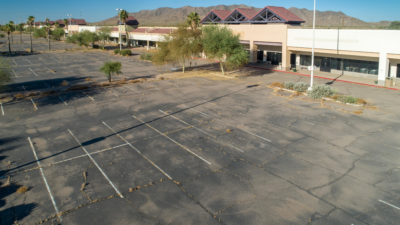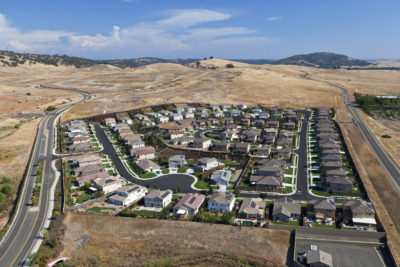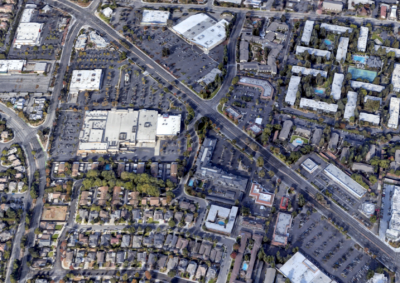Not just strip malls -- all malls.
Our Board of County Commissioners of St. Johns County has already approved conversion of a former outlet mall to housing. We shall see if it is "affordable." (Whatever that means).
From YaleEnvironment360:
How Ailing Strip Malls Could Be a Green Fix for U.S. Housing Crisis

An abandoned strip mall in Casa Grande, Arizona. JIM PARKIN / ALAMY STOCK PHOTO
INTERVIEW
How Ailing Strip Malls Could Be a Green Fix for U.S. Housing Crisis
Urban designer Peter Calthorpe has a plan for the shuttered and financially troubled strip malls that dot the suburban landscape: Convert the malls into housing that would be part of green communities where people could be closer to their jobs and get out of their cars.
The U.S. housing shortage is so severe that demand outstrips supply by a stunning 3.8 million homes, according to Freddie Mac, the government-sponsored mortgage dealer. The shortage exacerbates homelessness, income inequality, and even climate destabilization, as greenhouse gas emissions increase while workers drive longer and longer distances between jobs and residences.
Peter Calthorpe, the heralded California-based urban planner, believes he knows how to lessen the housing and environmental crises at the same time. For decades, he has campaigned for more densely populated cities, rapid public transit, and an end to sprawl and reliance on cars, all tenets of the movement he cofounded, called New Urbanism. His books, including The Regional City: Planning for the End of Sprawl in 2001, as Metropolis magazine puts it, “define the recent history of urban design in its most vital and prescient manifestations.”
Now Calthorpe sees an opportunity in the economic wreckage left behind by the 2008 Great Recession. In an interview with Yale Environment 360, he notes that for most working families the pop of the housing bubble marked the end of “the American dream of the single-family home in a cul-de-sac and a couple of cars.” Since then, many tens of thousands of acres of commercial strip malls have fallen vacant or underutilized as consumers have relied increasingly on online purchases. As Calthorpe sees it, that’s land that could be occupied by millions of units of workforce housing, bringing workers close to their jobs, revitalizing streets and cities, and cutting carbon emissions in half.
Yale Environment 360: What led you to your idea of reinventing strip malls?
Peter Calthorpe: In the ’80s, I coauthored a book called Sustainable Communities. Solving for human needs and environmental well-being is at the essence of sustainable community. Sometimes that means that we can shape new places that are more benign environmentally and more diverse in terms of population and use, but right now, in the United States, this has to be done with infill. We’ve sprawled outwards for 50, 60 years in ways that are completely unsustainable. I personally believe the financial crisis of ‘08 wasn’t just about Wall Street. It was also about the fact that what [Wall Street was] selling — ever more distant, single-family subdivisions — was unaffordable to the working class of this country. It used to be that you could just drive an extra 10 miles and afford a house, but when that started to add up to 30, 40, 50 miles, the economic and health burdens of that commute, when stacked on the cost of housing, made the whole thing collapse. Wall Street had a lot of single-family inventory prior to the financial collapse, and they basically moved it into the pocketbooks of people who really couldn’t afford it. That’s the moment when the American dream of the Ozzie-and-Harriet single-family home in a cul-de-sac and a couple of cars really died.
We’d had stagnation in the income of working people for decades prior to that point, so the housing form no longer married well to the needs or economic capacity of a very large segment of our population, and the demographics also changed. The idea of subdivisions for all was based on nuclear families, but now they represent just 24 percent of households in America. So we’re ready on many, many levels for more urban living — urban in the best, not the worst, sense.
Then the question becomes, if we’re not going to build more subdivisions in cow pastures, where do we put the housing? About 15 years ago I did a study for the state of California called Vision California that outlined various scenarios of how California would grow through 2050. One was business as usual, with more subdivisions, more freeways, more malls. Another one was infill development: denser, more walkable, more transit-oriented, more mixed-use [retail and residential] buildings. We were able to document a huge range of benefits, both environmentally and in household costs. The media income in California was then about $50,000 a year, and the savings of living in a more compact, mixed-use environment were about $10,000 a year. This is a big, big number.
“From 2010 to 2018 in the Bay Area, we created 880,000 jobs and only 100,000 units of housing.”
The question hanging over that study was, “Okay, we know infill makes sense, and we know that more transit and walkable environments make sense, but where and how?” With local government control, it’s very difficult to do infill housing because existing populations are not particularly interested in opening the door to new and different people. Does this sound familiar on a national level?
e360: Absolutely.
Calthorpe: We all know about NIMBYism, “Not In My Backyard.” So we’ve been stuck since the crisis broke in 2008, and since then the production of housing, at least where I know best, in California, has almost completely stopped. From 2010 to 2018 in the Bay Area, we created 880,000 jobs and only 100,000 units of housing. Do you wonder why the cost of housing has gone up? If you don’t build enough of something, then what’s left will become more and more expensive. That of course pushes down on, first, working people, then low-income people, and then, at the bottom of the ladder, you get people ending up living on the street, the homeless crisis. They’re all linked.
We’ve overbuilt single-family homes, and we need more multi-family housing. It turns out, especially now, after COVID, that strip commercial land is completely underutilized. Since Amazon came along, you do your shopping on screen, not on the street, not in a strip mall, and yet the zoning remains the same. So you have these wastelands of asphalt, major arterial roads inhospitable to people and kids and bikes and lined with parking lots and single-story buildings that produce very little tax base or benefit to anybody.
A single-family housing development in El Dorado Hills, a suburb of Sacramento, California. ALLEN J. SCHABEN / LOS ANGELES TIMES VIA GETTY IMAGES
e360: So would the kind of multi-family housing you have in mind be built on top of existing strip malls, in malls that are converted to housing, or on the sites of shuttered malls?
Calthorpe: There is a large range of housing types that are appropriate, varying by site size, market, and construction costs. At the low-density end are live/work townhomes with small offices or flex space at the ground floor. Most common are “podium apartments” which have a concrete first floor containing parking and shops lining the streets with multi-story apartments or condos above. In areas well-served by transit, mid-rise buildings with ground floor shops and below-grade parking are possible.
e360: To what extent could this conversion of strip malls solve the California and U.S. housing problem?
Calthorpe: It is estimated that California has a housing deficit of around 2.5 million units. If the strip commercial land in just the Bay Area and Los Angeles County were 100 percent redeveloped, that could provide 2.6 million units. But that is largely multi-family housing, which is typically less than half the market. So it’s clear that it could satisfy 100 percent of multi-family needs.
e360: What percentage of these malls are dead or in trouble and could be readily available?
Calthorpe: I don’t have those numbers, but the United States, at 43 square feet per capita, has about five times the retail of most developed countries, and demand is falling due to online shopping. Strip malls are very underutilized, and nobody is investing in them.
“What really will solve climate change is the way we live. We don’t have to become poor, just more urban.”
In the midst of this, we developed software that allowed us to understand in detail every parcel of land in every region, including their dimensions and environmental impacts and proximity to schools and jobs and transit. We then did a study of one street, El Camino Real, which the Spanish missionaries used to colonize California, and it basically goes from the heart of Silicon Valley right to San Francisco — it’s in the epicenter of jobs. When we analyzed it, we found there was enough land to accommodate 250,000 housing units in the heart of Silicon Valley. These would be relatively small multi-family units that would be affordable and close to jobs.
Then you need to remake the street itself, make it a beautiful place to live — hence the term “Grand Boulevard.” We can add trees and bike lanes and wide sidewalks and bus rapid transit [dedicating one street lane in each direction to buses only]. We can make them places where people want to hang out and wander around. When you marry the street and the land together, you have solutions to the housing crisis and the transportation crisis and the community need for diversity and opportunity … It’s a model that creates ribbons of urbanism that interconnect everything.
We started with El Camino, and then I said, “Well, what about the whole Bay Area?” It turns out there are 700 miles of arterials in the Bay Area. There’s enough strip commercial land on that to build more than a million units of housing.
A rendering showing how El Camino Real in California could be transformed to accommodate housing and mixed-use development. URBANFOOTPRINT / URBANADVANTAGE
e360: What are the environmental benefits of doing this?
Calthorpe: In broad-brush terms, you’re talking about reducing carbon emissions by half. We keep saying that renewables and technology are what’s going to solve climate change. Actually, what really will solve climate change is the way we live. We don’t have to become poor, just more urban. We have to walk more. We have to live in buildings that are more compact and therefore need less energy, land, and water.
e360: And the aesthetic quality would certainly change because you would no longer have these strip malls. You’d have a lot more diversity, a lot more richness, correct?
Calthorpe: Yeah. The neat thing is that an arterial runs through different kinds of neighborhoods. If you get on El Camino, the whole 43 miles are the same experience. It’s just six lanes, parking lots and [ugly] buildings. But it’s actually passing through a whole sequence of really interesting, diverse places. It goes through little historic towns, but you don’t register them. A Grand Boulevard would touch so many kinds of places.
If you lived in a subdivision off El Camino, you’d still live in a single-family home. But you could walk or ride a bike to a vital urban street a block or two away where there are cafes and restaurants and street life is happening. Then you have the best of both worlds. So it’s not just good for the people who live on the Boulevard, it’s good for the people who live near it.
“It’s time to start looking at workforce housing for the people who don’t sit behind computer screens.”
e360: There’s bound to be a lot of opposition to this. Where is that going to come from? And how do you overcome it?
Calthorpe: Historically there are many factors. The biggest one is NIMBYs, people who live in especially wealthy communities and don’t want multi-family dense housing because it represents a different class of people. And they’re fearful of who they are and what they are. Well, the reality is, get over it. They’re the school teachers and the firemen and the policemen, and they’re everybody who makes your world work.
The opponents say that if you build these things, there’ll be traffic. Once again, get over it. We’re all going to have to slow down if we’re going to solve climate change. We’re all going to have to get out of the car a lot more.
e360: This is partly a zoning battle, isn’t it? You’d have to change zoning regulations in every city and town. Your approach would be to get legislation at the state level rather than fight the battle at every municipality — is that right?
Calthorpe: Correct. The NIMBYs are very much in control of local government, and they’re exclusionary. So local government is not a particularly advantageous place to argue for higher densities and infill. It needs state legislation enabling “as of right” zoning [which overrides local obstacles such as design review boards]. We now have a bill in the California assembly which basically creates “as of right” zoning and 15 percent affordable housing on all commercial land.
e360: That’s still pretty low, isn’t it — 15 percent?
Calthorpe: That’s because the reality is you would not get any construction if you pushed it higher. In today’s world of construction and materials costs, the economics of housing developing is just exorbitant. So my focus has been on workforce housing more than affordable housing because workers are the ones who are missing. It’s time to start looking at workforce housing for the people who don’t sit behind computer screens but who keep our world alive and are in some ways the heart and soul of our communities. They’re the ones who need housing opportunities, and it’s not just “affordable housing” — it’s modest multi-family housing.
The California bill has zero parking requirements. One of the reasons that workforce housing doesn’t happen is that parking structures are very expensive, $45,000 to $50,000 per stall, and that makes multi-family housing really expensive. It’s hard to imagine life without a car, but, quite frankly, more and more people are doing it. They have to be in a coherent urban environment that allows them to get to transit and to walk to local destinations. So this is a way of thinking it through.
The neat thing about grand boulevards is that the market is proven. I did it a long time ago for University Avenue in Berkeley, [California,] which used to be the highest crime part of our city because it was the least populated. And now it’s lined with multifamily housing, and it’s a lively street with lots of streetlights. It’s not like this is some utopian expectation. The development community really wants to get to work on solving the housing crisis. For them, it’s an economic opportunity.




No comments:
Post a Comment